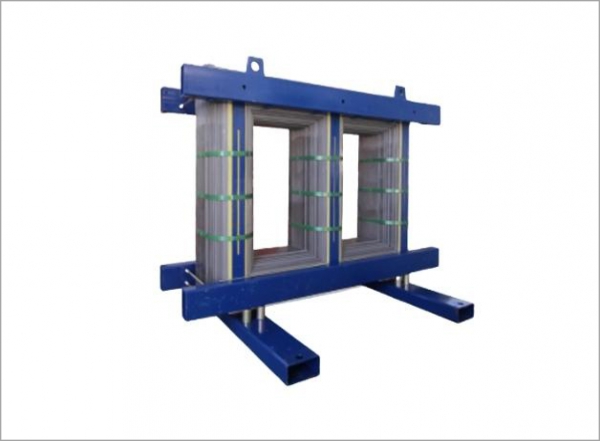In modern power systems, transformers are indispensable key equipment, and their core component, the transformer core, directly determines the performance and efficiency of the equipment. With the growth of energy demand and technological advancement, the precision transformer core has gradually become the focus of industry attention. It not only improves the overall performance of the transformer, but also provides important support for energy saving and consumption reduction, miniaturization design and green environmental protection.
The precision transformer core is a core component of the transformer made of high-precision processing technology and high-quality materials, mainly used for magnetic conduction and electromagnetic energy transmission. It is usually stacked by silicon steel sheets, amorphous alloys or other high-performance magnetic materials, with low loss, high magnetic permeability and excellent mechanical stability. Compared with traditional cores, precision transformer cores have higher requirements in dimensional tolerance, surface finish and magnetic properties to meet the high efficiency requirements of modern power equipment.
Advantages of precision transformer cores
Low energy consumption and high efficiency
The precision transformer core uses high-quality magnetic materials and reduces eddy current loss and hysteresis loss through optimized design. This low-loss characteristic significantly improves the energy conversion efficiency of the transformer, reduces operating costs, and reduces carbon emissions, which is in line with the global trend of energy conservation and emission reduction.

Miniaturization and Lightweight
With the continuous upgrading of electronic equipment and power systems, the market demand for miniaturized and lightweight transformers is increasing. Precision transformer cores achieve higher power density through advanced manufacturing processes, allowing transformers to provide equal or even higher performance in a smaller volume.
High stability and reliability
Precision machining technology ensures the geometric accuracy and consistency of the core, thereby improving the stability and reliability of the transformer under various working conditions. This is particularly important in areas such as high-voltage power transmission and new energy power generation that require extremely high equipment performance.
Environmental protection and sustainability
Precision transformer cores widely use recyclable materials (such as silicon steel or amorphous alloys) and indirectly reduce the consumption of fossil fuels by reducing energy losses. In addition, some new core materials (such as nanocrystalline alloys) further improve environmental performance and promote the development of green energy.
Manufacturing process and technological innovation
The manufacturing of precision transformer cores involves multiple complex processes, including material selection, stamping, annealing and stacking processes. Here are a few key links:
Selection of high-quality materials
Silicon steel sheets are the most commonly used core materials, which have good magnetic conductivity and low loss characteristics. In recent years, amorphous alloys and nanocrystalline alloys have gradually been used in high-end transformer core manufacturing due to their lower losses and higher efficiency.
High-precision stamping technology
Stamping is one of the core steps in core manufacturing. Precision stamping equipment can cut materials with micron-level precision to ensure that the size of each core is exactly the same. This not only improves assembly efficiency, but also reduces performance degradation caused by dimensional deviation.
Annealing treatment
Annealing is a heat treatment process used to eliminate internal stress of the material and restore its magnetic properties. Precision transformer cores undergo strict annealing control, which can significantly reduce hysteresis losses and extend service life.
Automated stacking
The stacking process of the core directly affects its overall performance. Modern automated production lines can quickly and accurately complete stacking, avoid errors caused by manual operation, and improve production efficiency.
Application areas
Precision transformer cores are widely used in the following areas:
Power transmission and distribution
In high-voltage transmission and distribution systems, precision transformer cores help achieve efficient power conversion, reduce line losses, and improve grid stability.
New energy generation
New energy systems such as wind power generation and photovoltaic power generation require efficient inverters and transformers, and the application of precision cores has greatly improved the performance of these devices.
Industrial automation
High-frequency transformers and power modules in industrial equipment rely on precision cores to achieve stable current output and efficient energy management.
Consumer electronics
Transformers in small electronic devices such as laptops and mobile phone chargers also widely use precision cores to meet the needs of high efficiency and compact design.
Future outlook
With the rapid development of emerging fields such as smart grids, new energy vehicles and 5G communications, the demand for precision transformer cores will continue to grow. In the future, the development of new materials (such as superconducting materials), the popularization of intelligent manufacturing technologies, and stricter environmental protection standards will further promote the development of this field. At the same time, the global pursuit of a low-carbon economy will also prompt more companies to invest in the research and development and production of high-efficiency transformer cores.
As the core component of the power system, precision transformer core is leading the innovation of energy conversion technology. It not only represents the high-level development of the manufacturing industry, but also makes important contributions to the sustainable development of society. In the future, with the continuous breakthrough of technology, precision transformer core will exert its potential in a wider range of fields and create a more efficient and green lifestyle for mankind.
 +86-523 8891 8899
+86-523 8891 8899  +86-523 8891 8266
+86-523 8891 8266  info@tl-core.com
info@tl-core.com  No.1, Third Industrial Park, Liangxu Street, Taizhou City, Jiangsu, China
No.1, Third Industrial Park, Liangxu Street, Taizhou City, Jiangsu, China 

 English
English Español
Español Türk
Türk 中文简体
中文简体